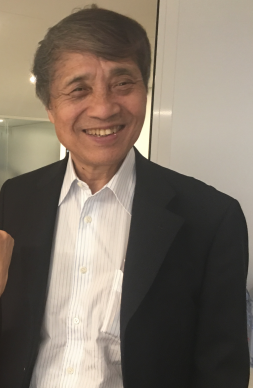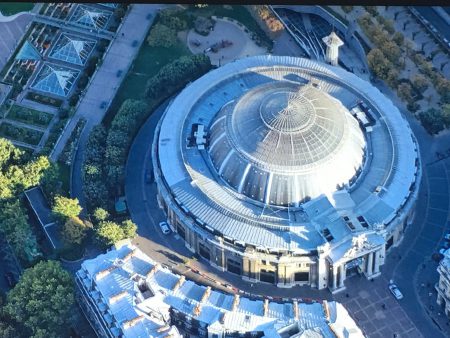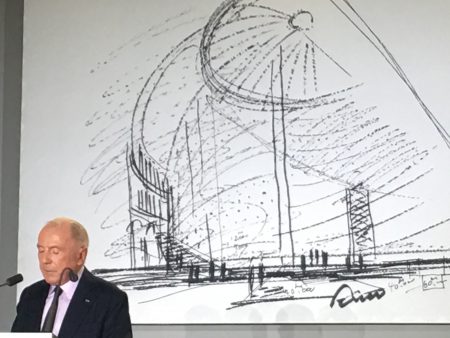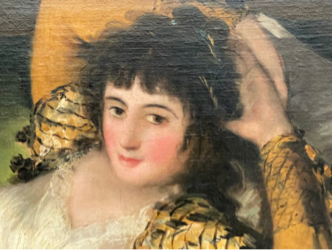The Japanese architect’s English is patchy, his French even more so, but thanks to his enthusiastic translator and his very considerate and witty wife Yumiko Ando, to whom I explained that I had visited her husband’s new building at the Clark Institute in Massachusetts, as well as his work in Tokyo (the house of the collector Takeo Obayashi) and Naoshima and Teshima, as well as Aix en Provence (Chateau La Coste) I managed to secure a precious half-hour interview for the following day.
He has a reputation for being tight-lipped.
On Monday morning at 11am, on the site of the former Paris Bourse de Commerce (a kind of Stock exchange), behind Les Halles, the various stakeholders in the Pinault Museum project were presenting their project to the media.
The history is fascinating – a real slice of Paris life.
In 1766, on the site of an hotel particulier, a building was erected for storing grain. On one side it is flaked by a tower built for astronomical observations, which dates to Catherine de Médicis (1577).
It’s a treasure unknown to most Parisians and still exists to this day.
In 1812 the inner courtyard of the grain store was covered with a glass cupola with a metallic structure – the first of its kind in the history of architecture.
In 1889 it was transformed into the stock exchange (Bourse de Commerce) and a section of the cupola was hidden by a large fresco painted to celebrate trade.
The Pinault Museum – not a Pinault Foundation as currently exists in Venice – will open its doors in late 2018.
In France, business foundations are encouraged by the State, and benefit from very generous tax breaks.
The most significant moment in François Pinault’s announcement at the press conference was undoubtedly when he underlined, at the request of a colleague, that it would not be a foundation because ‘I did not want to involve the State. I’ve put myself in the place of the general public. The money will be provided by the Pinault family and commits the next two generations.’
The provisional cost of the renovation is 108 million euros, and will provide 3,000m2 of exhibition space.
Tadao Ando met François Pinault some 30 years ago at a dinner organised by Karl Lagerfeld.
Subsequently he masterminded the transformation of the Palazzo Grassi and the Punta della Dogana, in Venice converting them into museums for the french collector.
Ando recounts in his hoarse voice that he originally thought that the project to develop a museum in the Bourse de Commerce would take 10 years.
The great architects are all brilliant storytellers and this is how they carry their audience. On this occasion Ando makes reference to Plato who spoke about perfection through the circle and the square.
In the circular building, topped by an exceptional 70m-diameter skylight, Ando decided to install a concrete cylinder.
He would later tell me ‘a circular shape inside a circular shape in the centre of the city in the epicentre of art, between the Louvre and the Pompidou Centre.
The circle is a symbol of planet earth too.’
Tadao Ando is a spiritual person.
The cylinder, nicknamed the drum by the other architects, consists of a metallic base into which concrete is poured. The historic is a container for the hyper-contemporary.
The past is a container for the future.
The Japanese architect adds, ‘reinforced concrete is a French invention. I wanted to bring it back home.’
Later that afternoon, during our face-to-face interview I asked Tadao Ando what is his strategy when designing a museum.
His response is the exact opposite to what I was expecting: ‘Art and architecture have to collide. When I created this cylinder for the Pinault Museum, this large round space, I left no option but to install powerful works there when the museum opens. The concept is used rarely in museums. Obviously there’s the Guggenheim in New York but because of the slope I think that it is hard to see the paintings.’
I mention the Oscar Niemeyer Museum in Niteroi in the suburb of Rio, which from the outside is magnificent but a catastrophe in its hanging of works.
He retorts: ‘what we’re going to do at the Bourse de Commerce is better than these two examples. I’m lucky: it’s better and I’ve done nothing.’
It is hard to get Tadao Ando to talk about a subject of your choice.
He wouldn’t reply to my question about how he discovered art, the first shock in the subject.
He sidesteps the question, by telling me how he collaborated with artists.
He mentions Ellsworth Kelly, Walter de Maria and Richard Serra for whom he apparently clearly has a great deal of admiration.
He compares his relationship with artists to a boxing match, with lots of tension.
He talks the same way about his relationship with Francois Pinault.
Boxing is a subject that is particularly dear to him and he began his professional life as a boxer.
So why did he quit boxing?
‘I was not good enough,’ replies the man with the broken nose.
To try to detain him a little longer, I speak to him about Piranesi’s staircases, those imaginary 18th century prisons, with their extraordinary and nightmarish views.
They are architectural flights of fancy which, as Martin Bethenod, director of the Pinault Foundation and Collection, pointed out to me, Ando makes references to as early as the ’80s.
Likewise, at that time he spoke of the Pantheon in Rome as the ultimate example of architecture.
Finally, as the Bourse de Commerce contains a double spiral staircase (from the 18th century) and a dome with a giant oculus, it is easy to compare it with Ando’s biggest sources of inspiration.
Would the Pinault Museum not be the culmination of his career?
He replies: ‘It’s true. The Piranesi stairs are the infinite, the eternal.’
To reward me for this last minute comparison, he draws a little sketch of the Bourse de Commerce dome on his business card, which he offers to me and then disappears moments later after adding:
‘If ever I have an exhibition at the Pompidou Centre, we shall continue our interview.’
Watch this space…
Support independent news on art.
Your contribution : Make a monthly commitment to support JB Reports or a one off contribution as and when you feel like it. Choose the option that suits you best.
Need to cancel a recurring donation? Please go here.
The donation is considered to be a subscription for a fee set by the donor and for a duration also set by the donor.














